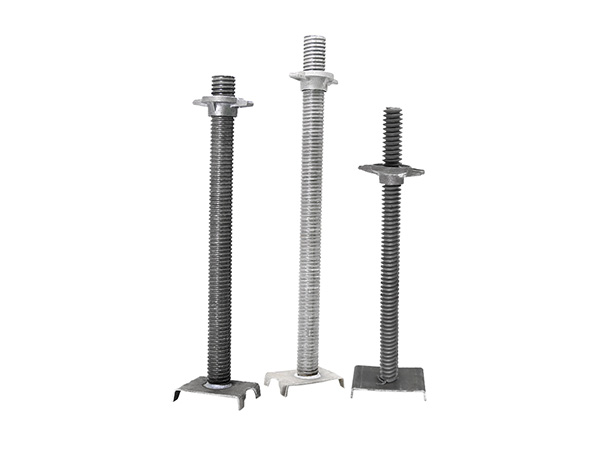- Site Navigation -

Scaffolding Screw Jack
A Scaffolding Screw Jack,also known as a scaffold base jack or adjustable jack,is a critical height-adjustment component used in scaffolding systems to level and stabilize structure......
A Scaffolding Screw Jack,also known as a scaffold base jack or adjustable jack,is a critical height-adjustment component used in scaffolding systems to level and stabilize structures on uneven surfaces.Composed of a threaded steel rod(acme or trapezoidal thread for load-bearing efficiency),a hexagonal or square base plate,and a nut with integral handle,it enables precise vertical positioning of scaffold standards(uprights)to accommodate ground irregularities while ensuring structural integrity.
Design and Construction
Threaded Rod:Typically made from high-grade carbon steel(EN 10025 S275JR)or alloy steel,the rod features coarse,continuous threading with a diameter ranging from 32mm to 48mm(1.25"to 1.9").The acme thread profile—with its wider flanks and 29°angle—provides superior load distribution and resistance to stripping compared to standard V-threads.
Base Plate:A circular or square steel plate(150-200mm in diameter)welded or forged to the rod’s lower end,distributing the scaffold’s weight over a larger ground area to prevent sinking.Plates may include drainage holes for water runoff in outdoor applications.
Adjustment Nut:A heavy-duty cast iron or steel nut with a welded rotating handle(wing nut or T-handle)for manual height adjustment.Some models feature a lock nut to secure the adjusted position against vibration-induced loosening.
Top Plate/Cup:The upper end often incorporates a swivel cup or U-head to cradle scaffold standards,allowing 5-10°of angular adjustment for alignment with diagonal braces.
Load Capacity and Safety Standards
Working Load Limit(WLL):Ranges from 2 tonnes to 8 tonnes per jack,depending on rod diameter and material grade.EN 12811-1(European)and ANSI/ASSE A10.8(American)standards mandate minimum safety factors of 2.5x for ultimate tensile strength.
Adjustment Range:Typically 150mm to 600mm(6"to 24")of vertical travel,with maximum extension limited to 2/3 of the rod length to maintain stability—exposed threads beyond this threshold compromise load-bearing capacity.
Material Testing:Rods undergo tensile testing(minimum yield strength 235 MPa),nut torque testing,and base plate bending tests to ensure compliance with scaffolding regulations.
Installation and Operation
Placement:Positioned on firm,compacted ground or concrete pads,with base plates fully seated to prevent tilting.
Height Setting:Rotating the adjustment nut raises/lowers the top plate;a spirit level ensures plumb alignment of standards.
Locking:Tightening the lock nut(if equipped)against the base plate secures the adjusted height.
Load Distribution:Multiple jacks are spaced per scaffold design(typically 1.2-2.4m apart)to evenly distribute dead and live loads(workers,materials,equipment).
Applications
Construction Scaffolding:Leveling tube-and-coupler,system,or frame scaffolds on sloped terrain,uneven concrete,or gravel surfaces.
Formwork Support:Adjusting vertical props for concrete formwork,ensuring precise alignment of slabs and beams.
Temporary Structures:Stabilizing stages,grandstands,and event platforms,with corrosion-resistant galvanized models used for outdoor events.
Industrial Maintenance:Supporting access towers during equipment repairs,with high-load variants(5+tonnes)used in heavy industry.
Safety Considerations
Inspection:Pre-use checks for bent rods,stripped threads,cracked base plates,or seized nuts;damaged jacks must be removed from service.
Overload Prevention:Never exceed WLL;calculate total scaffold load(dead load+500kg/m²live load)and distribute across sufficient jacks.
Environmental Protection:Galvanized or powder-coated finishes prevent rust in humid/damp environments;in coastal areas,stainless steel components resist salt corrosion.
Wind Resistance:Properly braced scaffolding systems reduce lateral forces on jacks,preventing overturning.
Variants and Accessories
Swivel Base Jacks:Feature a pivoting base plate(±15°)for extreme ground slopes,common in civil engineering projects.
Screw Jack with Wheel:Integral casters for temporary mobility,used in adjustable work platforms.
Anti-Twist Nut:Hexagonal nut designs prevent rotation during scaffold climbing,maintaining height settings.
Load Indicator:Premium models include mechanical or digital load cells to monitor weight distribution,alerting to overload conditions.
Compliance and Certification
Reputable manufacturers produce jacks certified to EN 74-1(Scaffold couplers and fittings)and OSHA 1926.451(Scaffolding safety standards).CE marking requires conformity assessment through notified bodies,ensuring traceability of materials and production processes.
In summary,the Scaffolding Screw Jack is an indispensable component in temporary access systems,blending mechanical simplicity with critical safety functionality.Its robust design,precise adjustability,and adherence to global standards make it a cornerstone of construction site safety and efficiency.








